|
|
Butterflies - Swallowtails -
More Information
|
|
|
|
~ Click on any image for an enlargement - scrollable if it is too big for browser window ~
|
|
Kingdom: Animalia
Phylum: Arthropoda
Subphylum: Hexapoda
Class: Insecta Pterygota
Order: Lepidoptera
Superfamily: Papilionoidea
Family: Parnassians and Swallowtails Papilionidae
Subfamily: Papilioninae
Family Description: The Papilionidae belong to the Superfamily Papilionoidea, the true butterflies. Swallowtails are worldwide in distribution and comprise approximately 560 species. They are richest in the tropics, and their brilliant colors make them favorites of butterfly enthusiasts. Many swallowtail species, especially in the tropics, mimic other butterflies that are distasteful, while others are distasteful and cause birds and other vertebrate predators to regurgitate. Swallowtail adults are medium to large and may or may not have tails, while parnassian adults are medium, tailless, and have translucent wings. All adult parnassians and swallowtails have three pairs of walking legs, and adults of all species visit flowers for nectar.
Subfamily Description: Swallowtails (Papilioninae) are members of the Family Papilionidae. They comprise about 560 species, have a worldwide distribution, and are richest in the tropics. Many are brilliantly colored and are favorites of butterfly enthusiasts. Many species, especially those in the tropics, mimic other butterflies that are distasteful, while others are distasteful and cause birds and other vertebrate predators to regurgitate. Adults are medium to large, may or may not have tails, and have three pairs of walking legs. Adults of all species visit flowers for nectar. Males of most species patrol for mates, while males of one group (Black, Old World, Anise, and Indra Swallowtails) perch on hilltops or ridges instead of patrolling. Swallowtails lay globular eggs and overwinter as pupae. Some species spend more than one year in the pupal stage, likely to survive drought years when little caterpillar food is available. In arid areas, the Black, Anise, and Indra Swallowtails often display this strategy.
|
Black Swallowtail
Eastern Tiger Swallowtail |
Giant Swallowtail
Palamedes Swallowtail
|
Pipevine Swallowtail
Spicebush Swallowtail
Zebra Swallowtail
|
Black Swallowtail
Papilio polyxenes
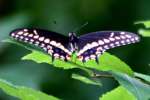 |
- Identification: Upper surface of wings mostly black; on inner edge of hindwing is a black spot centered in larger orange spot. Male has yellow band near edge of wings; female has row of yellow spots. Female hindwing with iridescent blue band. In the Southwest, yellow forms predominate in the subspecies P. coloro.
- Life history: Males perch and patrol for receptive females. Female lays eggs singly on leaves and flowers of the host, which are then eaten by hatching larvae. Hibernates as a chrysalis.
- Flight: One-2 flights from April-October in northern regions of range; 3 flights in southern regions.
- Wing span: 3 1/4 - 4 1/4 inches (8 - 11 cm).
- Caterpillar hosts: Leaves of plants in the parsley family (Apiaceae) including Queen Anne's Lace, carrot, celery and dill. Sometimes plants in the citrus family (Rutaceae) are preferred.
- Adult food: Nectar from flowers including red clover, milkweed, and thistles.
- Habitat: A variety of open areas including fields, suburbs, marshes, deserts, and roadsides.
- Range: Most of the eastern U.S., north into Quebec, west into s. Saskatchewan, Colorado and se. California; south to n. South America. Subspecies coloro in desert Southwest.

|
|
Eastern Tiger Swallowtail Butterfly
Papilio glaucus

Eastern Tiger Swallowtail Dark Female
Papilio glaucus
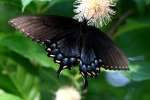
|
- Identification: Male is yellow with dark tiger stripes. Female has 2 forms: one yellow like the male and the other black with shadows of dark stripes. Hindwing of both female forms has many iridescent blue scales and an orange marginal spot. On the underside of forewing of both female forms the row of marginal spots has merged into a continuous band.
- Life history: Males patrol for receptive females. Females lay eggs singly on host leaves. Caterpillars eat leaves and rest on silken mats in shelters of curled leaves. Chrysalids overwinter.
- Flight: 3 flights from February-November in Deep South; 2 flights from May-September in north.
- Wing span: 3 5/8 - 6 1/2 inches (9.2 - 16.5 cm).
- Caterpillar hosts: Leaves of various plants including wild cherry (Prunus), sweetbay (Magnolia), basswood (Tilia), tulip tree (Liriodendron), birch (Betula), ash (Fraxinus), cottonwood (Populus), mountain ash (Sorbus), and willow (Salix).
- Adult food: Nectar of flowers from a variety of plants including wild cherry and lilac (Syringa vulgaris).
- Habitat: Deciduous broadleaf woods, forest edges, river valleys, parks, and suburbs.
- Range: Eastern North America from Ontario south to Gulf coast, west to Colorado plains and central Texas.

|
Giant Swallowtail Butterfly
Papilio cresphontes
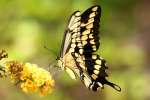 |
- Identification: Forewing with diagonal band of yellow spots. Tails are edged with black and filled with yellow.
- Life history: Males patrol for receptive females. Females lay single eggs on host leaves and twigs. Caterpillars resemble bird droppings and eat leaves and young shoots. Chrysalids hibernate.
- Flight: Two in the north from May-September; all year in Florida and the Deep South.
- Wing span: 4 - 6 1/4 inches (10.2 - 16 cm).
- Caterpillar hosts: Trees and herbs of the citrus family (Rutaceae) including Citrus species, prickly ash (Zanthoxylum americanum), and hop tree (Ptelea trifoliata).
- Adult food: Nectar from lantana, azalea, bougainvilla, bouncing Bet, dame's rocket, goldenrod, Japanese honeysuckle, and swamp milkweed.
- Habitat: Many locales including rocky and sandy hillsides near streams or gullies in the north; pine flats, towns, and citrus groves in the south.
- Range: Throughout eastern North America west to the Rocky Mountains, south through the desert Southwest to South America. A rare stray to Quebec, North Dakota, and Bermuda.

|
Palamedes Swallowtail Butterfly
Papilio palamedes
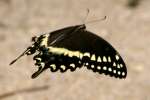 |
- Identification: Upper surface of hind- and forewings with postmedian yellow bands; tails are filled with yellow. Lower surface of hindwing with thin yellow basal stripe and postmedian band of yellow-orange crescents.
- Life history: Not reported.
- Flight: Two flights, March-December in North; partial 3rd flight in South.
- Wing span: 4 1/2 - 5 1/8 inches (11.4 - 13 cm).
- Caterpillar hosts: Plants of the Laurel family (Lauraceae) especially redbay (Persea borbonia).
- Adult food: Nectar from flowers of sweet pepperbush, thistles, blue flag, and azalea.
- Habitat: Wet woods near rivers and broadleaf evergreen swamp forests.
- Range: Along Atlantic coast from southern New Jersey (rare) to Florida; west and south along Gulf Coast to central Mexico.

|
Pipevine Swallowtail Butterfly
Battus philenor
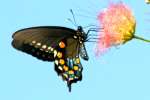 |
- Identification: Upper surface of hindwing iridescent blue or blue-green. Underside of hindwing with submarginal row of 7 round orange spots in iridescent blue field.
- Life history: Adult males patrol likely habitat in search of receptive females. Females lay batches of eggs on underside of host plant leaves. Caterpillars feed in small groups when young but become solitary when older. Wintering is by the chrysalis.
- Flight: In the East and California, adults fly primarily in late spring and summer, but the butterfly is commoner in late summer and fall in the South and Southwest. Where lack of freezing temperatures permit, adults may fly continuously. In lowland tropical Mexico they may be found in any month.
- Wing span: 2 3/4 - 5 inches (7 - 13 cm).
- Caterpillar hosts: Pipevines (Aristolochia species), including Aristolochia californica, A. serpentaria and others.
- Adult food: Solely nectar from flowers including thistles (Cirsium species), bergamot, lilac, viper's bugloss, common azaleas, phlox, teasel, azaleas, dame's-rocket, lantana, petunias, verbenas, lupines, yellow star thistle, California buckeye, yerba santa, brodiaeas, and gilias.
- Habitat: A wide variety of open habitats, open woodland, and woodland edges.
- Range: Rare stray to Canada (s. Manitoba). Tropical lowlands south to southern Mexico.

|
Spicebush Swallowtail Butterfly
Papilio troilus
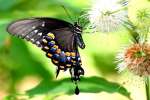 |
- Identification: Upper surface of forewing is mostly black with ivory spots along margin. Upper surface of hindwing has orange spot on costal margin and sheen of bluish (female) or bluish-green (male) scales. Underside of hindwing with pale green marginal spots.
- Life history: Males patrol in woods, roads and woodland edges to find receptive females. Females lay single eggs on underside of host plant leaves. Caterpillars live in shelters of folded-over leaves and come out to feed at night. Some chrysalids from each generation hibernate.
- Flight: 2 generations per year from April-October. In Florida, several generations between March-December.
- Wing span: 3 - 4 inches (7.5 - 10 cm).
- Caterpillar hosts: Spicebush (Lindera benzoin), sassafras trees (Sassafras albidum); perhaps prickly ash (Zanthoxylum americanum), tulip tree (Liriodendron tulipifera), sweetbay (Magnolia virginiana), camphor (Cinnamomum camphora), and redbay (Persea borbonia).
- Adult food: Nectar from Japanese honeysuckle, jewelweed, thistles, milkweed, azalea, dogbane, lantana, mimosa, and sweet pepperbush.
- Habitat: Deciduous woodlands, fields, roadsides, yards, pine barrens, wooded swamps, and parks.
- Range: Eastern states from southern Canada to Florida; west to Oklahoma and central Texas. Occasionally strays to North Dakota, central Colorado, and Cuba.

|
Zebra Swallowtail Butterfly
Eurytides marcellus
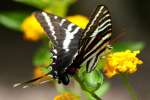 |
Identification: Upper surface of wings with black stripes on pale whitish-green background; hindwings have very long tails. Early-spring form is smaller and lighter colored.
Life history: Adult males fly in the understory near host plants to find females. Females lay single green eggs on lower leaves of host plant. Caterpillars live and feed on the underside of these leaves, then pupate and hibernate there.
Flight: Two flights, April-August, in the northern part of its range; many flights, March-December, in the south.
Wing span: 2 1/2 - 4 inches (6.4 - 10.4 cm).
Caterpillar hosts: Shrubs of the genus Asimina (pawpaw) in the Annonaceae family. Young plants are preferred.
Adult food: Moisture from sand and nectar from flowers including blueberry, blackberry, lilac, redbud, viper\'s bugloss, verbena, dogbane, and common milkweed.
Habitat: Breeds in moist low woodlands near swamps and rivers. Adults fly to nectar plants in open fields and brushy areas.
Range: Rare in northern part of range. 
|
| Information / Identification Sources: |
For identification our primary reference is Butterflies of North America - Kaufman Focus Guides - by Jim P. Brock & Ken Kaufman. We also use internet sources when in question - typically BugGuide and Jeff's Butterfly Page. Our text information (above) comes from Butterflies & Moths of North America. |
|


